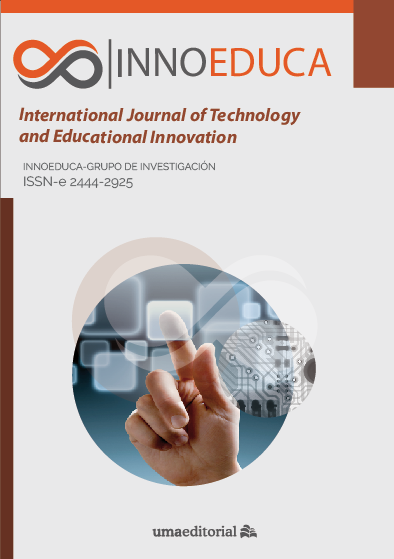Medición de la absorción musical en una muestra de estudiantes: análisis psicométrico de la escala AIMS
Contenido principal del artículo
Resumen
En algunas personas, la música parece ejercer la capacidad de aislarlos de su entorno y captar toda su atención. La medición de esta característica de la persona es aconsejable antes de utilizar la música en el aula, sobre todo se usa para apoyar tareas académicas complejas. Esta investigación ha medido las propiedades psicométricas de la escala AIMS de absorción a la música, así como sus niveles en una muestra incidental de 388 estudiantes de Educación. Se aplicó un análisis factorial exploratorio. Se realizó un análisis de estadísticos descriptivos y los contrastes en función del sexo, así como de saber o no música. Los resultados muestran dos factores latentes vinculados con un estado alterado de conciencia, y otro con experiencias cinestésicas. La muestra presenta niveles medios y altos en ambas dimensiones. No se encontraron diferencias entre sexos ni conocimiento musical.
Palabras clave:
Detalles del artículo
Referencias
Bigand, E., Vieillard, S., Madurell, F., Marozeau, J., & Dacquet, A. (2005). Multidimensional scaling of emotional responses to music: The effect of musical expertise and of the duration of the excerpts. Cognition & Emotion, 19(8), 1113–1139. https://doi.org/10.1080/02699930500204250 DOI: https://doi.org/10.1080/02699930500204250
Hallam, S., Price, J., & Katsarou, G. (2002) The Effects of Background Music on Primary School Pupils' Task Performance. Educational Studies, 28(2), 111-122. https://doi.org/10.1080/03055690220124551 DOI: https://doi.org/10.1080/03055690220124551
Herbert, R. (2011). Musical and non-musical involvement in daily life: The case of absorption. Musicae Scientiae, 16(1), 41–66. https://doi.org/10.1177/1029864911423161 DOI: https://doi.org/10.1177/1029864911423161
Jameson, E., Trevena, J., & Swain, N. (2011). Electronic gaming as pain distraction. Pain Research & Management: The Journal of the Canadian Pain Society, 16(1), 27–32. https://doi.org/10.1155/2011/856014 DOI: https://doi.org/10.1155/2011/856014
Juslin, P. N. (2016). Emotional Reactions to Music. En S. Hallam, I. Cross, y M. Thaut (Edts.), The Oxford Handbookd of Music Psychology (pp.197-213). Oxford University Press. DOI: https://doi.org/10.1093/oxfordhb/9780198722946.013.17
Kämpfe, J., Sedlmeier, P., & Renkewitz, F. (2010). The impact of background music on adult listeners: a meta-analysis. Psychology of Music, 39, 424–448. https://doi.org/10.1177/0305735610376261. DOI: https://doi.org/10.1177/0305735610376261
Knight, W.E.J., & Rickard, N.S. (2001). Relaxing music prevents stress-induced increases in subjective anxiety, systolic blood pressure, and heart rate in healthy males and females. Journal of Music Therapy, 38(4), 254–272. https://doi.org/10.1093/jmt/38.4.254 DOI: https://doi.org/10.1093/jmt/38.4.254
Lehmann, J.A.M., & Seufert, T. (2017) The Influence of Background Music on Learning in the Light of Different Theoretical Perspectives and the Role of Working Memory Capacity. Frontier of Psychology 8(1902.). https://doi.org/10.3389/fpsyg.2017.01902. DOI: https://doi.org/10.3389/fpsyg.2017.01902
Mitchell, L.A., MacDonald, R.A.R., & Brodie, E.E. (2006). A comparison of the effects of preferred music, arithmetic and humour on cold pressor pain. European Journal of Pain, 10(4), 343-351. https://doi.org/10.1016/j.ejpain.2005.03.005 DOI: https://doi.org/10.1016/j.ejpain.2005.03.005
Nagy, K., & Szabó, C. (2002). Individual differences in musical involvement. In C. Stevens, D. Burnham, G. McPherson, E. Schubert, & J. Renwick (Eds.) ICMPC7. Proceedings of the 7th International Conference on Music Perception & Cognition (pp. 506-509). Casual productions.
Nillson, U. (2008). The anxiety -and pain- reducing effects of music interventions: a systematic review. AORN Journal, 87(4), 780-807. https://doi.org/10.1016/j.aorn.2007.09.013 DOI: https://doi.org/10.1016/j.aorn.2007.09.013
Posner, J., Russell, J., & Peterson, B. (2005). The circumplex model of affect: An integrative approach to affective neuroscience, cognitive development, and psychopathology. Development and Psychopathology, 17(3), 715-734. https://doi.org/10.1017/S0954579405050340 DOI: https://doi.org/10.1017/S0954579405050340
R Core Team (2020). R: A language and environment for statistical computing. R Foundation for Statistical Computing, Vienna, Austria. https://www.R-project.org/.
Radstaak, M., Geurts, S. A. E., Beckers, D. G. J., Brosschot, J. F., & Kompier, M. A. J. (2014). Recovery and well-being among Helicopter Emergency Medical Service (HEMS) pilots. Applied Ergonomics, 45(4), 986–993. https://doi.org/10.1016/j.apergo.2013.12.002 DOI: https://doi.org/10.1016/j.apergo.2013.12.002
Rey, G. (2012). A review of research and a meta-analysis of the seductive detail effect. Educational Research Review, 7, 216–237. Https://doi.org/10.1016/j.edurev.2012.05.003 DOI: https://doi.org/10.1016/j.edurev.2012.05.003
Robles, A., Nieto, Ch., Cuadros, J., & Pérez Hidalgo, I. (2010) Escala de Absorción Tellegen. Hipnológica, 3, 31-36. https://doi.org/10.1037/t14465-000 DOI: https://doi.org/10.1037/t14465-000
Roche, S. M., & McConkey, K. M. (1990). Absorption: Nature, assessment, and correlates. Journal of Personality and Social Psychology, 59(1), 91–101. https://doi.org/10.1037/0022-3514.59.1.91 DOI: https://doi.org/10.1037/0022-3514.59.1.91
Sandstrom, G. M., & Russo, F. A. (2013). Absorption in music: A scale to identify individuals with strong emotional responses to music. Psychology of Music, 41, 216-228. https://doi.org/10.1177/0305735611422508 DOI: https://doi.org/10.1177/0305735611422508
Tellegen, A., & Atkinson, G. (1974). Openness to absorbing and self-altering experiences (‘absorption’), a trait related to hypnotic susceptibility. Journal of Abnormal Psychology, 83(3), 268–277. https://doi.org/10.1037/h0036681 DOI: https://doi.org/10.1037/h0036681








